How Much Does it Cost to Develop a Ride-Sharing App
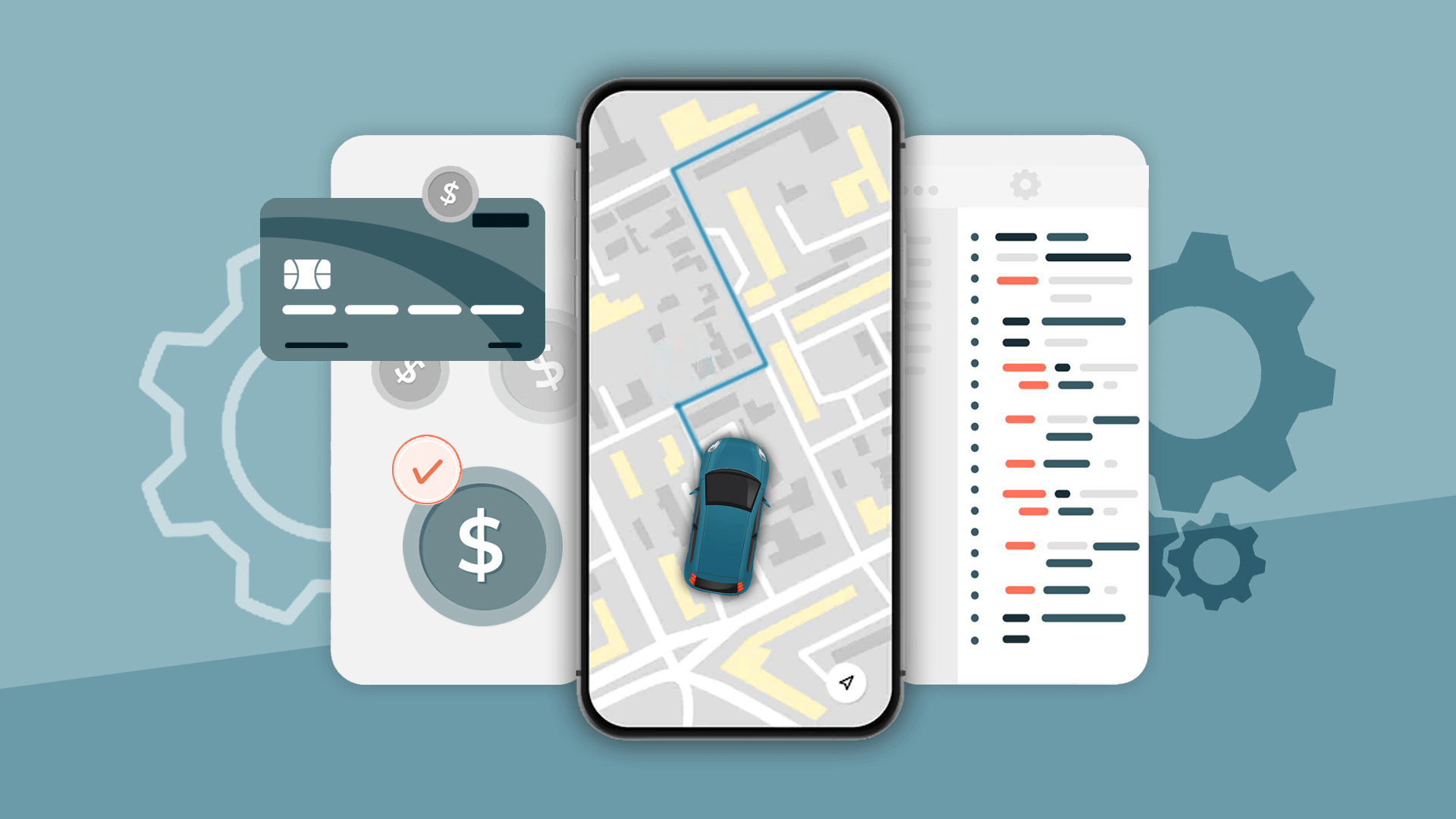
In the years ride sharing applications have become widely recognized as convenient and practical transportation options significantly changing the way people commute. As cities continue to grow, ride sharing companies, like Uber and Lyft have gained a reputation. Made significant advancements. These industry giants have not revolutionized our travel experiences. Have also created a thriving market.
Ride hailing industry has attracted high demand, predicting the revenue that would amount to $154.00 billion by the year 2023. According to Statista’s analysis, this positive tendency will become more significant with a CAGR 2023 – 2027 of 7.04%. This is predicted to culminate into a market size of $202.20 billion in The forecasted number of users for the ride hailing sector will exceed 1.92 billion people by that time.
The costs and key factors driving app development in ride sharing will be explored as well as other matters such as industry trends and finance. Our guide goes from basic elements up to real cases giving users a general panorama on how to come up with an Uber like app. Come and learn about the various facets of development and the most integral questions you need to ask yourself for your project. For any aspiring entrepreneur who doesn’t already know it, or inquisitive of what makes them, here is a guide to the expenses on the ride-sharing technology revolution.
Explore with us:
- The major cost components in this case.
- Industry trends shaping the landscape.
- Your financial travel toward a technology journey.
- Fundamental components – cost breakdown.
- Insight from real life case studies.
Start your journey as a ride-sharer – learn about the costs involved in becoming successful.
Understanding the Basics of Ride-Sharing Apps
Ultimately, ride-sharing applications are innovative service platforms where potential users can find nearby drivers using an easy app. The new digital paradigm has redefined how people commute. Instead of taking taxis as was their usual practice in most places, they have been able to communicate effectively using mobile apps thereby eliminating travel expenses. The core feature common to such applications is called ‘shared mobility’, which involves different travelers using one journey.
How Ride-Sharing Apps Work
The process is started by the users who make a booking via the app giving the pick-up point and destination. The app’s algorithm subsequently pairs up the user with a nearby available driver. The app enables users to track the driver’s live location, arrive time estimates, and online payment methods. This effortless process improves user experience, thus increasing the number of users preferring it.
Essential Features:
There are some basic elements that make up ride-sharing apps, which is what makes them work and why they’re popular. These typically include:
- User Profiles: It offers registration and profiling of users and drivers for creating individualized and secure experiences.
- Real-Time Tracking: It allows for tracking the drivers’ location, and also estimated time of arrival bringing forth transparency and convenience.
- In-App Payments: Such cashless transactions facilitate payments making them much more secure and efficient compared to other traditional modes.
- Rating and Review System: This allows for ratings and review of one another which enhances accountability and earns one’s trust in a community.
- Route Optimization: This ensures efficient routes are selected thereby ensuring maximum effectiveness in the system.
Benefits of Developing a Ride-Sharing App:
- Convenience: Real time tracking facilitates effective planning of rides by users at will.
- Cost-Effective: Such apps are mostly inexpensive compared to taxis.
- Reduced Traffic Congestion: These apps create an opportunity for people to share rides which reduces the levels of individual road vehicles and in turn alleviates traffic congestions.
- Increased Income Opportunities: Participation in ride-sharing by drivers creates other sources of income and gives room for flexible working time.
- Environmental Impact: Sharing of mobility can reduce carbon emissions as they help in the effective utilization of existing automobiles.
The basic concepts in app development that concern the utilization of ride-sharing apps as inspiration gives a starting point to delving into the complex web of app creation. However, the next few chapters will deal with the key cost components of implementing such dynamic systems.
Factors Influencing the Cost of Developing a Ride-Sharing App
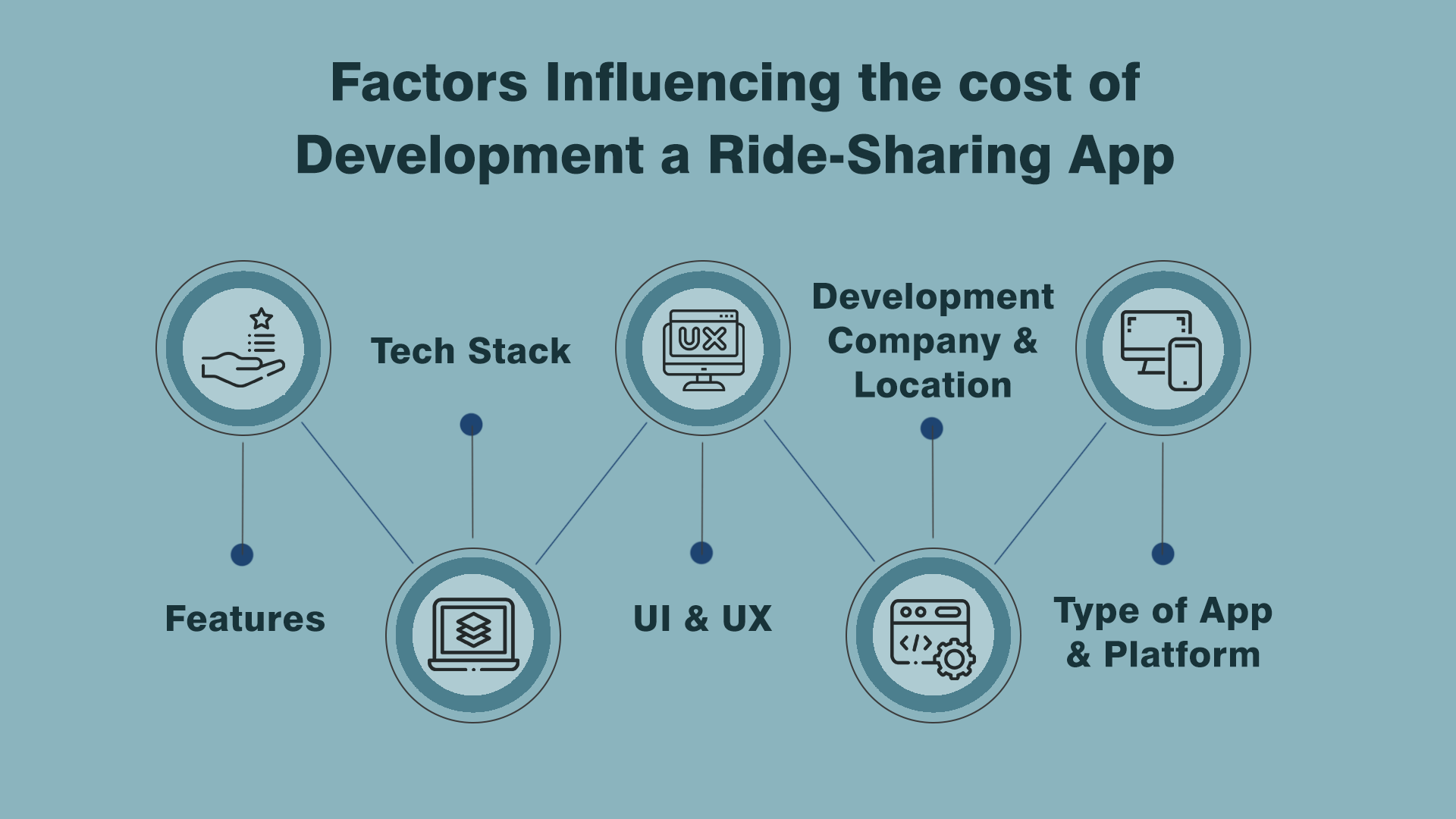
Successfully developing a ride-sharing app is based on careful consideration and analysis of multiple inputs that add up to the total development cost. We will now consider the main components which are important for the money investments necessary to develop a cab-sharing application.
Platform Development Costs
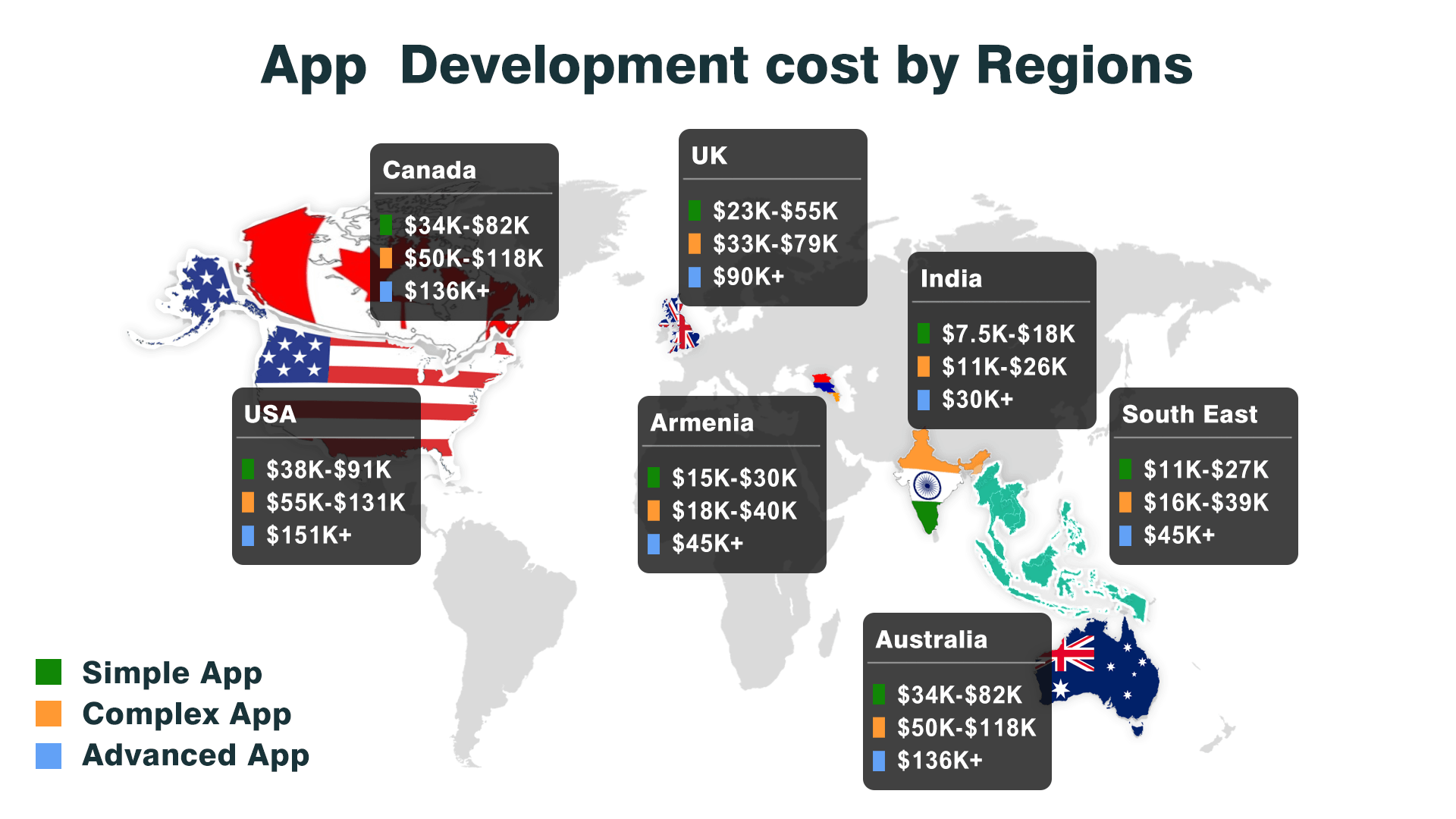
The first of these decisions is the selection of the platforms for implementation in ride-sharing app development. These two main contenders are IOS and android, which have different considerations. Hybrid development involves choosing both platforms which provide a wider coverage of the market but leads to high cost because of different coding and optimization requirements for each platform separately. Here's a breakdown of estimated development costs:
| Platform | Development Cost (Estimated Range) |
|---|---|
| IOS | $30,000 - $50,000 |
| Android | $25,000 - $45,000 |
| Hybrid | $50,000 - $80,000 |
Your platform, however, will depend upon how you define your target market, approach to marketing, as well as financial resources available. It is therefore important to understand these costs vary and plan accordingly on what decisions have to be made towards the end of the planning.
App Complexity and Design
Development costs depend on how complicated the ride-sharing app will be. For instance, an average basic app that has essential features such as user profiles and real-time tracking, as well as in-app payment, is much cheaper than a complicated app with extra functionalities. Here's a breakdown based on complexity levels:
| Complexity Level | Development Cost (Estimated Range) |
|---|---|
| Basic | $25,000 - $40,000 |
| Moderate | $40,000 - $80,000 |
| Complex | $80,000 - $150,000 |
Starting with a simple app would suffice for a small organization while sophisticated apps may be needed by the users who want a full-scale application. In terms of considering the appropriate complexity level for an app, a balance between function and cost should be attained.
App Features
Consequently, built-in factors within developed ride-sharing affect the level of its expense. On this basis, every characteristic brings about additional intricacy while creating it. Here's a breakdown of costs associated with key ride-sharing app features:
| Feature | Development Cost (Estimated Range) |
|---|---|
| Real-Time Tracking | $15,000 - $25,000 |
| In-App Payments | $20,000 - $35,000 |
| User Profiles | $10,000 - $20,000 |
| Rating System | $15,000 - $25,000 |
These ensure that the app is more adjustable to different users’ needs. Real-time tracking assures transparency, and in-app payment makes it convenient. This gives you an opportunity to understand what will be expensive, which allows you to prioritize in accordance with the goals and monetary funds allocated there to your application.
In subsequent chapters of this paper, we will talk at length on various aspects of ride-sharing app development cost.
Case Studies - Uber and Lyft: Unraveling the Development Journey
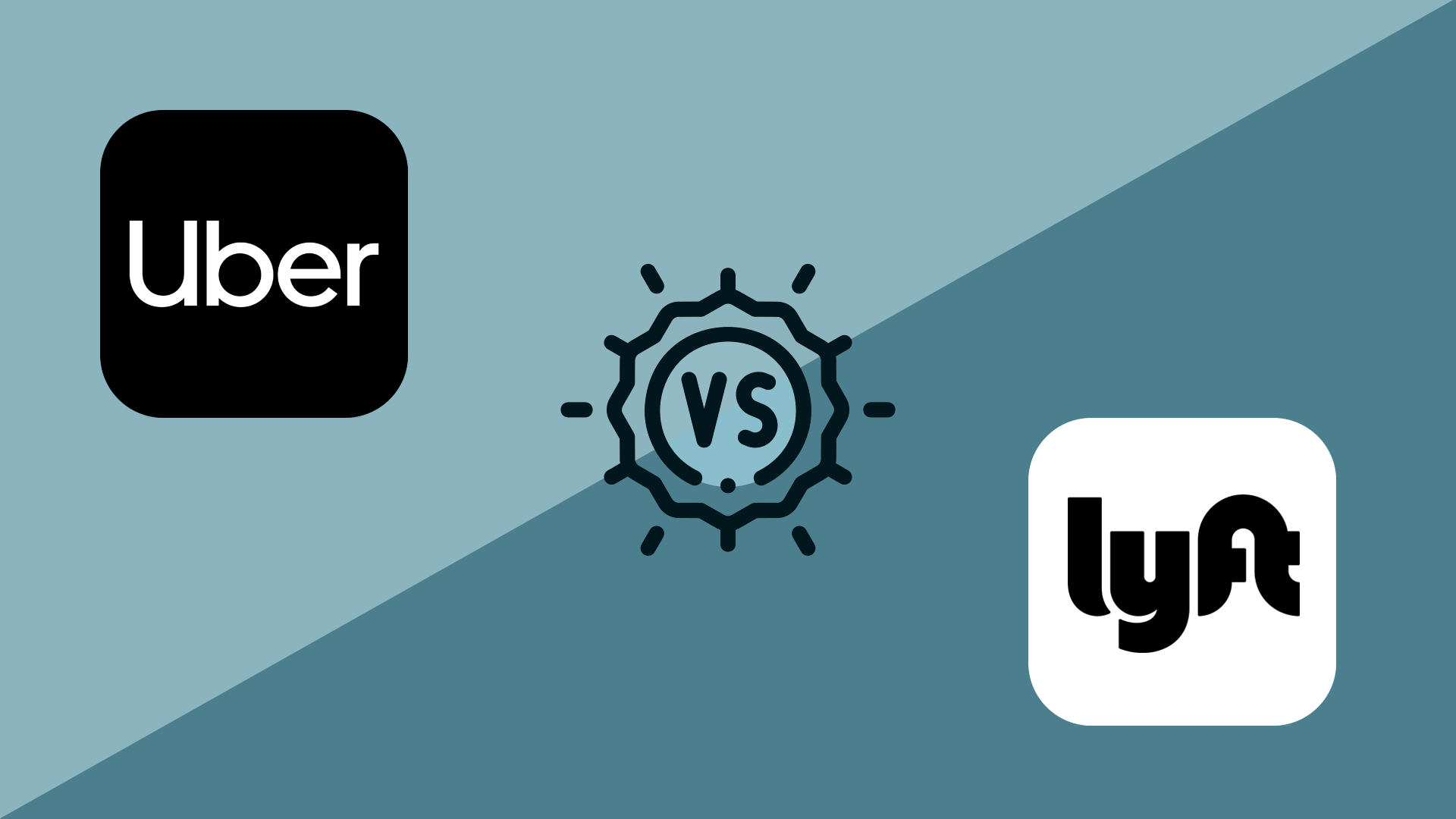
The rise of Uber and Lyft are testimonials on how understanding the development journey of industry pioneers can help appreciate what they went through during their journeys and how it all led to this point.
Uber
In 2009, Uber came up and changed how urban transport is done around the world. Uber’s growth process involved huge amounts of investment, innovative thinking, and strong emphasis on customers’ satisfaction.
Insights into Uber's Development Journey:
- Founding Ideation: It was conceptualized as Uber taxi, an innovative and comfortable way to transport people around town. Travis Kalanick and Garrett Camp, among other founders, sought a technological resolution to the difficulties urban transportation posed.
- Aggressive Expansion: Uber applied a rapid expansion approach to different countries across the globe. The methodology called for a strong and agile technology system that could cope with the increasing user population.
- Technological Innovation: Uber made massive investments into technology through features like real time tracking, cashless payments as well as surge pricing. The innovations raised the user experience bar and gave a new level for the entire on-demand transportation market.
- Financial Investment: Uber’s development path significantly relied on funding which they secured through several financing rounds. Thus, the high rating of Uber showed that investors had faith in the prospects behind the ride-sharing concept.
Uber’s story illustrates how revolutionary technological advancements can turn even startups into gigantic ride-sharing companies operating at a global scale. It started with numerous strategic choices, massive investment, and unbreakable commitment for the best possible customer’s experience which formed Uber. Although Uber’s precise startup expenditures remain confidential, early software development is expected to have ranged around $1 million to $1,5 million on minimum.
Uber - Key Expenses and Income (Estimated):
| Aspect | Estimated Cost/Income |
|---|---|
| Initial App Development | $1 million - $1.5 million (estimate) |
| Marketing and Promotion | Multi-million dollars (annually) |
| Driver Acquisition | Substantial investment |
| Technology Infrastructure | High operational expenses |
| Revenue Generation | Billions in annual revenue |
Lyft
Founded in 2012, lyft became a formidable rival to uber featuring unique brand and customer experience.
Highlighting Lyft's Unique Features and Approaches:
- Brand Differentiation: On the other hand, Lyft opted for differentiation of its brand while using a friendly, community-based philosophy. This led to an increased perception of cordiality in the brand. The company made this aspect even better by introducing such features as the “Glowstache” (that was later renamed into Amp) on drivers’ dashboards, resulting in an extra friendly look.
- Driver and Passenger Incentives: Lyft came up with creative rewards for its drivers and riders as well.QW These features included tipping and destination mode where one driver could drive to pick up passengers who were going in the same direction. It aimed at creating a mutual relationship between customers and drivers.
- Cultural Values: Lyft puts much weight on cultural factors by ensuring that it is seen in the public eye to be an accountable and friendly platform. As such, users seeking a ride- sharing service based on similar sentiments would find them in this strategy.
Lyft - Key Expenses and Income (Estimated)
| Aspect | Estimated Cost/Income |
|---|---|
| Initial App Development | $500,000 - $1 million (estimate) |
| Marketing and Promotion | Significant investment |
| Driver Incentives | Competitive spending |
| Technology Infrastructure | Operational expenses |
| Revenue Generation | Billions in annual revenue |
Comparing Development Strategies
Market Approach
- To this end, Uber opted for a global expansion approach and expanded its presence to various parts of the world at an impressive rate.
- In the beginning, Lyft started with the US market which it later expanded to other countries.
Branding and Image
- Uber exuded an air of corporate professionalism.
- Its brand was one that was rather casual and communitarian in comparison to those of its competitors such as Uber.
Pricing and Incentives
- The firms used competitive pricing strategies as well as attractive driving bonuses in an effort to get new users and drivers.
Technology and Innovation
- Uber and Lyft continually developed new technologies including sharing of rides, live-tracking, and in-application payment services.
Although they had common routes of developing, their subtle dissimilarities in branding and markets enabled them to operate within the sharing economy. The opposite approach is illustrated by Uber’s global expansion vs Lyft’s focus on community and local engagement within the dynamic international arena of ride sharing.
Steps to Create a Ride-Sharing App: Navigating the Development Journey
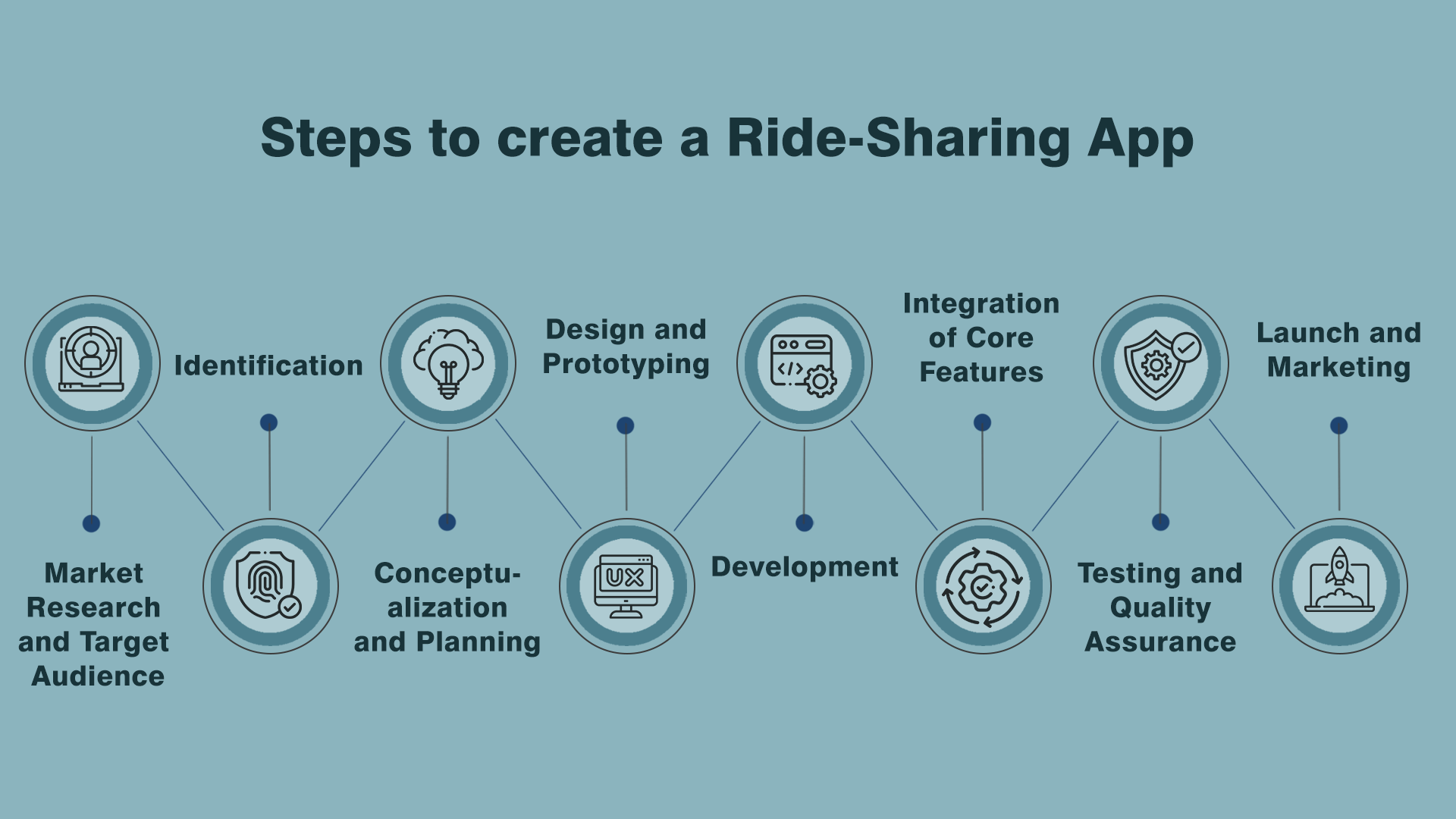
The process of creating a ride-sharing app is systematic and meticulous in nature; it entails a great deal of thought. Here's a step-by-step guide, along with the importance of critical considerations, to help guide you through the development stages:
Market Research and Target Audience Identification
Market research has to be very thorough before jumping into the development stage. Know your target audience, assess its needs, and identify current competitors. Know how market shifts affect your app. Ensure it meets what your potential users want.
Conceptualization and Planning
Create one guiding idea for your ride-sharing app design. What makes you stand out? With this focus, you'll grow, matching your app with what the market wants.
Design and Prototyping
For a good ride-sharing app, a pleasing user interface is key. This needs well-designed models/wireframes and mock-ups. These show how app elements work together. Check carefully for any UX/UI problems.
Development
In the growth phase, an app gets unveiled. Choose your programming platform(s) and pick suitable coding for the functions you want. Testing for issues should be an ongoing process starting from the introduction of development.
| Development Stage | Technology Stack |
|---|---|
| Frontend Development | |
| User Interface (UI) | React Native or Flutter (for cross-platform development) |
| User Experience (UX) | HTML, CSS, JavaScript |
| Backend Development | |
| Server-Side Language | Node.js, Python, Ruby on Rails |
| Framework | Express (for Node.js), Django (for Python), Ruby on Rails (for Ruby) |
| Database | MongoDB, PostgreSQL, MySQL |
| Mobile App Development | |
| Mobile App Framework | Flutter, React Native |
| Real-Time Tracking | |
| Real-Time Data Sync | WebSocket (for real-time updates) |
| In-App Payments | |
| Payment Gateway | Stripe, Braintree, PayPal |
| Security | |
| Authentication | OAuth, JWT |
| Encryption | SSL/TLS |
Integration of Core Features
Add important components like live tracking, user profiles, and internal payment options within the app. Make sure that the functionality of the app aligns with what you thought from the beginning and your market research results.
| Driver App | Passenger App | Admin Panel |
|---|---|---|
| Registration | Registration | Booking management |
| User profile | Ride booking | Location management |
| Trip notifications | Real-time tracking | Trip fares management |
| Navigation | Ride history | Notification management |
| Messaging | Filtering | Feedback management |
| Rating and reviews | In-app payments | Driver and user support |
| Reports of trips | Fare calculator | Call system management |
| Waiting time | Messaging & calling | Promotion and discount |
| - | Book for others | Payroll management |
| - | Push notifications | - |
Testing and Quality Assurance
It tests an application so that it is bug free and reliable. Carry out usability, performance, and security tests to detect and fix the issues that can negatively impact a user experience.
Launch and Marketing
Before launching an app, make sure to test and fix it thoroughly. Develop a marketing strategy that will make the target audience aware of the app. Use social media, partnerships, and promotional campaigns to get people talking about your product.
Table of Features with Estimated Hours and Costs:
| Feature | Estimated Hours | Development Cost (Approx.) |
|---|---|---|
| User Registration | 40 hours | $5,000 - $8,000 |
| Real-Time Tracking | 80 hours | $15,000 - $25,000 |
| In-App Payments | 60 hours | $10,000 - $18,000 |
| User Profiles | 40 hours | $6,000 - $10,000 |
| Rating System | 50 hours | $8,000 - $12,000 |
| Route Optimization | 70 hours | $12,000 - $20,000 |
| Driver Management | 60 hours | $9,000 - $15,000 |
Keep in mind, the estimates for hours and costs are just guides. They change depending on the app's size, the team's knowledge, and other factors.
Making a great rideshare app is a process. It takes multiple steps. It's important to keep a close eye and adjust continually to match the changing circumstances. That's how your app stays thriving in a tough market setting.
Cost Breakdown: Navigating the Financial Landscape of Ride-Sharing App Development
To create a ride-sharing app, there are several stages, each with its related costs: design, coding, and testing. Now, let's delve into the expenses involved in building such an app.
App Design
The app's design plays a key role in defining its look and usability. The design cost hinges on a few factors: the complexity and the number of features to implement.
| Component | Wireframing/Prototyping |
|---|---|
| UI/UX Design | $10,000 - $20,000 |
| Wireframing/Prototyping | $5,000 - $10,000 |
App Development
Developers then code the app following the design efforts and the planned features. This stage's cost varies, as it depends on platform intricacies, the app's features, and whatnot.
| Component | Estimated Cost Range |
|---|---|
| Frontend Development | $30,000 - $50,000 (for both iOS and Android) |
| Backend Development | $40,000 - $60,000 |
| Real-Time Tracking | $15,000 - $25,000 |
| In-App Payments | $20,000 - $35,000 |
| User Profiles | $10,000 - $20,000 |
| Rating System | $15,000 - $25,000 |
| Route Optimization | $25,000 - $40,000 |
| Driver Management | $20,000 - $30,000 |
Testing and Quality Assurance
The app needs rigorous testing to weed out any bugs for smooth operations. Testing cost? It swings on factors like the number of planned tests, as well as the app's complexity.
| Component | Estimated Cost Range |
|---|---|
| Usability Testing | $5,000 - $10,000 |
| Performance Testing | $8,000 - $15,000 |
| Security Testing | $10,000 - $20,000 |
Launch and Marketing
The cost of launching the app includes some expenses for marketing, promotion, and initial user acquisition.
| Component | Estimated Cost Range |
|---|---|
| Marketing Campaigns | $20,000 - $50,000 (varies based on scale) |
| App Launch Events | $10,000 - $20,000 (optional) |
Maintenance and Ongoing Costs
Continuous upkeep of the app’s performance and security alongside adherence to platform updates becomes critical.
| Component | Estimated Cost Range (Monthly) |
| Bug Fixes and Updates | $5,000 - $10,000 |
| Server Hosting | $2,000 - $5,000 |
| Customer Support | $3,000 - $8,000 |
Potential Hidden Costs and Optimization Strategies
- Legal and Compliance Costs
Extra charges may occur based on how the business handles its legal obligations and adheres to rules and regulation bodies. Having enough money set aside for legal advice is very important.
- Scalability
Think about future growth needs. At start, growth features may not be a priority, but not planning ahead can result in large expenses down the road.
- Data Security
It is important for companies investing to invest in robust data security . Although this increases upfront expenses, it ensures against potential breaches that might incur huge financial losses.
- Optimization Strategies
Select a set of prioritized features depending on users’ needs, financial capacities, and technological limitations.
Use a cross-platform development framework to cut development costs for various platforms..
Spread out the costs through phased developments and launches.
The ride-sharing app has its own complex financial landscape that needs careful analysis in advance, good timing decisions, and a continuous eye for future opportunities that might arise during scaling processes.
How Can I Develop an App Like Uber? Navigating Common Concerns and Challenges
Thus, if you have heard about the ride sharing revolution, you are thinking about designing an application like Uber. It is interesting but as in everything that is ambitious there are doubts and not so true statements. Frequently asked questions concerning operationalizing your ride share idea.
Common Concerns
- Market Saturation: Some people are wondering whether we have reached capacity in the ride-sharing market. There are always these niches, these untapped markets or these unique consumer wishes that could be captured with due consideration of the appropriate strategy.
- Technology Complexity: It can be pretty complicated to come up with a ride-sharing app. Though with a perfect strategy and technology setup it’s possible. The process will be made easy by using cross-platform frameworks as well as collaborating with experienced developers.
- Regulatory Challenges: This process of regulatory compliance can, therefore, be overwhelming at times. Nonetheless, getting updated, working closely with legal practitioners, and actively addressing compliance issues might forestall the regulatory problems.
Feasibility
The truth of the matter is, it is possible to build an app similar to Uber as long as a good plan is applied. First, embark on intensive marketing research. Determine unattended holes/under served segments within the ride-sharing system. Look into regional considerations, what users want and unfulfilled needs that your app may address. This focused strategy improves your app’s viability and relevance in the market.
Use the lessons from Uber, and other giant ride-sharing companies. Know customer expectations, examine best features and define weaknesses. You can formulate a value proposition around the pricing model, customer’s improved experience, or the innovations and special offers you provide.
Potential Challenges and Solutions
- Competition: There are many rivals competing for every little share of the market; however, differentiation can be the way. You can also create your own niche as a result, by differentiating yourself, for instance, providing special benefits to clients, offering novelty, unique features, better user experience, etc.
- Technology Costs: Though expensive, careful planning can minimize the costs of coming up with a strong app. Focus on vital components, phase the process of development, and evaluate cheap technological alternatives.
- Regulatory Compliance: Work closely with lawyers so as to comply with local laws. This proactive engagement can help address problems in future as well.
- Driver and User Acquisition: It is important to be able to attract both driver and user. To begin with, the use of attractive incentives, referral programs, and specialized brand target marketing may foster first-time patronage and retention activities.
Conclusion: Navigating the Ride-Sharing App Development Landscape
Therefore, as we have discovered crucial points along our path through the complexities towards ride sharing app creation, here are some important points that will help you through your transformational technological expedition. We have explored the forces that shape what the cost is to bring your app to life, from the basic understanding to case stories of industry leaders such as Uber and Lyft.
Key Takeaways
- Understanding Costs: Planning is crucial in creating a ride-sharing app. The costs are separated into four parts, that is, design and development, testing, and maintenance. A well-managed budget must carefully consider every piece.
- Development Journey: The approach was presented in a sequence comprising market research, strategic planning, and users centricity approach. The process is based on a structured roadmap so that developers can follow it from conceptualization to launch.
- Case Studies: The industry also saw contributions from Uber and Lyft as a source of information concerning the evolutionary phase taking place in the industry. The various aspects of their development strategies, costs, and unique features can be considered in light of newcomers to the ride-sharing terrain.
- Challenges and Solutions: A ride-sharing app construction is not devoid of difficulties. We identified concerns associated with market overflooding, technology difficulties, and regulatory barriers and suggested workable means of dealing with them.
Your Next Steps
Remember to think of your peculiarities, your audience, and the limitations by the budget while considering your way to ride sharing apps. Put the user's needs first and use cheap technology for cost-cutting purposes in development.
Remember, differentiation is key. Innovative features, a unique user experience, and targeting of a narrow group of potential users to get your app noticed in this competitive market.
Read also Cost To Build A Logistics App Development.
In case of looking for assistance on ride sharing app business and have special queries, feel free to seek our advisory service at Addevice without any charges. If you have any questions or would like to share your ideas, fears, dreams, talk to us. Come aboard and let’s get going exploring your dream in the realm of technological innovation in the sharing economy.
Estimate Your Ride-Sharing App's Development Cost
Let's discuss your project and provide a customized cost estimate
Our offerings include:
✅ Detailed cost breakdown
✅ Customized development strategies
✅ Expert consultation
Table of contents
FAQ
Development cost of an app like Lyft varies depending on these factors; platform - iOS or Android, complexity, features. A figure for creating an app like Lyft would vary between USD 80,000 and USD 150,000. However, you must go deeper into your very own specific requirements to come up with another and improved one.
Creating a ride-sharing app involves several key steps:
- Market Research: Find out who your customers are, analyze competitors, and realize the needs of users.
- Conceptualization and Planning: Describe the main characteristics; unique features of the app and overall image.
- Design and Prototyping: A wireframe and a prototype showing how an app would be built, and how it flows.
- Development: Develop the application following the specified features and components.
- Integration of Core Features: Critical elements such as live tracking, payment, user profile, and route optimization.
- Testing and Quality Assurance: Test the app for its usability, efficiency and safety with a high degree of rigor.
- Launch and Marketing: You will download the application hereafter and then undertake market campaigns in order to inform your target audience of this product.
Creating an app like Uber is similar to building a brand new ride sharing app. Therefore, the cost may vary depending on the platform option, level of application complexity, design complexity, as well as specific features included in the app. An average cost for an Uber clone app can be around $100,000 – 200,000 dollars. However, you should carry out an extensive evaluation of your actual required specification so as to get a better budget figure.
Building an app might prove expensive considering its costs vary based on the operating system (iOS, Android, and both), application complexity, sophisticated design, and the number of incorporated features. Simple apps featuring a few functions can be priced at anywhere between $25k and $40k. Additional costs of up to $80,000+ and above may arise as you include new features and complexity. Ensure you clearly define the requirements of your app so that an accurate quotation is provided for your special requirements.
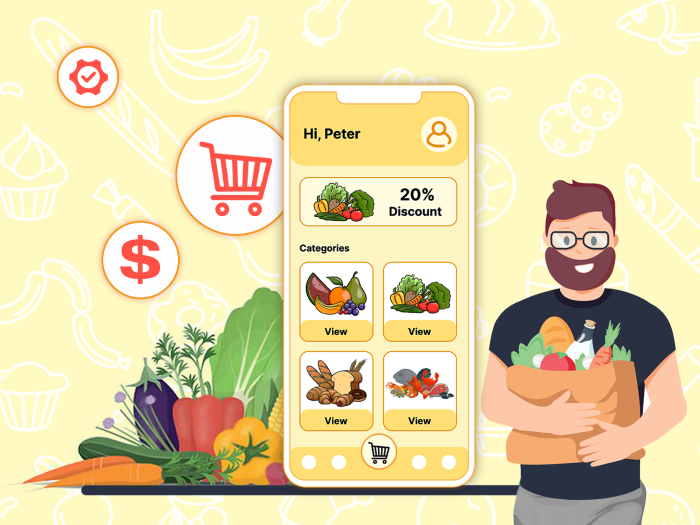 Grocery Delivery App Development: Tips, Cost & Steps
Grocery Delivery App Development: Tips, Cost & Steps
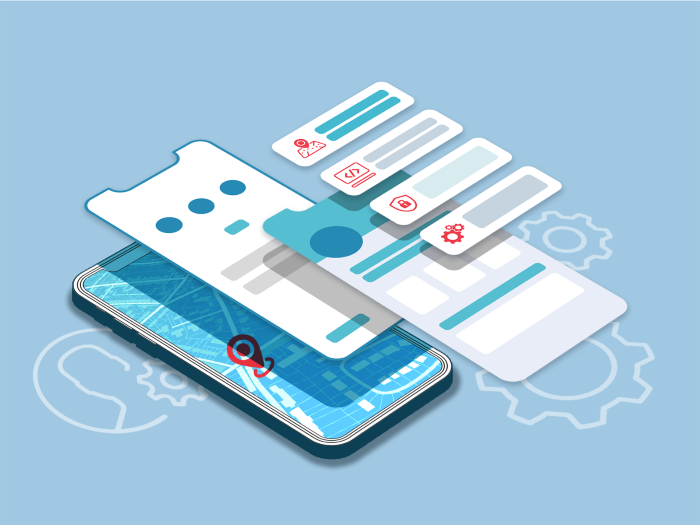 Must-Have Uber App Features: Building a Ridesharing App
Must-Have Uber App Features: Building a Ridesharing App
 How to Make an App Like Uber: Features and Tech Details
How to Make an App Like Uber: Features and Tech Details